Hello guys,
I am going to show you a place that is quite unique in Trieste.
It is situated about 6 km away from the city center.
This place is called Risiera di San Sabba.
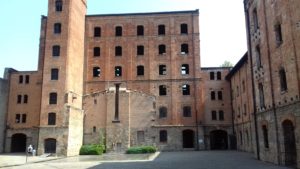
This five-storey brick-built compound was built in 1913 and used to be a rice-processing factory.
But during WWII, when Germans soldiers occupied Trieste (1943-1945),
this factory was used as a concentration camp to transport, detain and kill prisoners.
Many prisoners were jews but there were also political prisoners coming from the Slovenian
and Croat community and also Italians.
20,000 to 25,000 prisoners (according to historians) were detains in Risiera di San Sabba.
During WWII, this camp was the only one in Italy equipped with a gas chamber.
More than 3000 prisonners were killed in this concentration camp by the nazis.
A large majority of them were killed in gas chamber and dozens were shot by rifles or guns.
Risiera di San Sabba is now a civic museum and a memorial (since 1975).
More than 200,000 people come visit this museum every year.
A large part of them are pupils and high school students on a school trip to Trieste.
Many school groups visit this museum every week (from Italia, Slovenia, Austria, Germany etc …).
Those of you guys who might visit Trieste one day and never had the opportunity
to go visit Auschwitz, Dachau, Buchenwald or other former concentration camps in Europe…
just know that there is a former concentration camp right here, in Trieste.
But be warned, the visit of this former camp is very interesting but it can aslo be overwhelming.
The feeling of uneasiness already starts at the entrance of the museum.
The architect who disigned the museum in its current appearance created a narrow entrance
between 2 huge reinforced concrete walls leading to the courtyard of Risiera di San Sabba…
as if he wanted us to be mentally prepared for what we’re about to see.
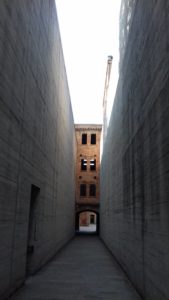
The visit of the museum is free of charge but if you really want to get the story,
I recommend you to rent an audioguide at the reception. It cost only 3€.
You’ll be able to choose among many languages (Italian,French, German, English).
Once you’ll get the audioguide, you will see a large courtyard on your way out.
The rooms on the uppers floors of the former factory are not opened to the public.
But you’ll be able to visit many rooms on the ground floor of the museum.
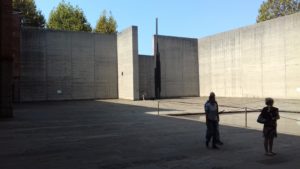
A killing room, a Crematorium and its chimney used to be in the courtyard of Risiera di San Sabba.
In an effort to hide their crimes, nazis blew them up at the 29th of April 1945 just before the camp was liberated.
The remain of the former crematorium can still be seen on the wall of one of the building.
Large metal plates on the ground show traces of the crematorium and a black steel monument
now stands at the exact location where the chimney used to be.
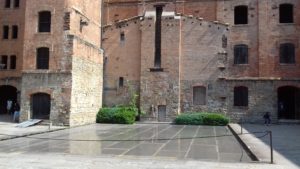
Prisoners in this camp were jews, civilians prisoners and military prisoners.
Jewish prisoners were deported to other camps (Auschwitz, Dachau, Mauthausen etc…) towards a tragic destiny.
The 3 first rooms, near the courtyard, are the Death Cell, the Cells and the Hall of crosses.
Prisoners who were put in the Death Cell waited there before being killed or deported.
That room is almost completly dark and is absolutly not cosy.
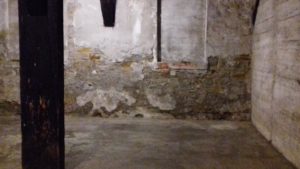
A few meters to the right, you’ll find the Cells … a large room with many small cells.
Some of these cells had wooden bunk beds without mattresses.
Up to 6 prisoners were locked in these tiny cells.
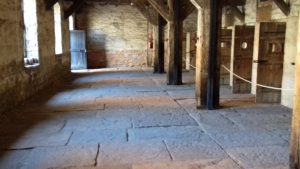
The most impressive room was probably the Hall of crosses.
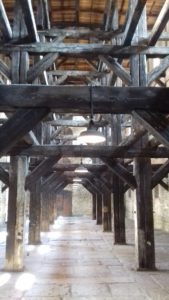
In this very large room, prisoners waited to be deported to other concentration camps in Germany.
During the German occupation, boards of the upper floors (of the former factory) have all been removed
so that the wooden beams and pillars were visible right up to under the roof.
This room is called “Hall of Crosses” because of the crossed-shape of the wooden support.
In that room are exhibited some of the personal items (stolen by nazis) who belonged to the jews who were deported.
One of the objects displayed behind a glass is a small urn containing a bit of soil from Jerusalem.
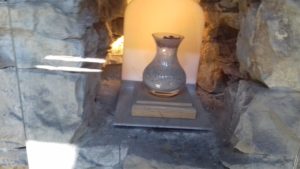
Other objects exhibited were pillaged by nazis soldiers from jewish houses in Trieste.
These objects were found by the allies inside jute saddlebags and were sent to Rome,
where they remained forgotten for decades in a vault of the Treasury.
In 2000 these stolen objets were finally returned to the Jewish Community of Trieste,
which decided to exhibit part of it in its own museum and to donate a small selection
to the Civic Museum of the Risiera di San Sabba.
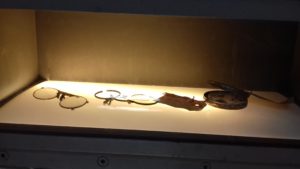

A bit further, in another part of the museum, you’ll find an exhibition room called the “Commemoration Room“.
To get there, you’ll have to walk under a little arch, to the left of the former crematorium.
Keep walking a little bit and you’ll find the “Commeroration Room”.
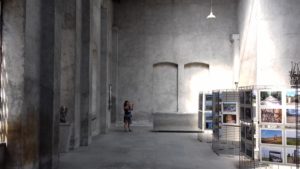
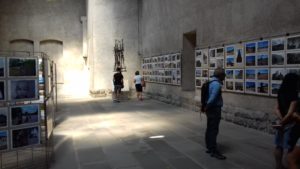
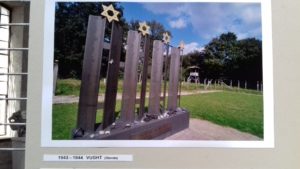
Do not miss this room.
Inside, you’ll find a 1958 scultupture of Marcello Mascherini called “Monument to Auschwitz”.
You’ll also find many pictures of other concentration camps in Europe during the 1940s.
If you take time to look at all the pictures exhibited on the walls, you’ll be shocked
by the large number of concentration camps that used to exist in Europe.
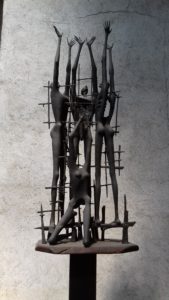
When you get out, look at all the commemoration plates on the concrete wall facing the commemoration room.
You’ll see plates written in many languages and you’ll realize than not only jews died here.

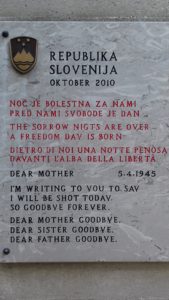
The tour of the museum will end in a large room, a bit in the dark.
In that room are exhibited objetcs that belonged to the jews who were detained in concentration camps
and many information panels explaining how life used to be in these camps during WWII.
You’ll also be able to see videos of the trial of people who were responsible for the murders
of prisoners at the Risiera di San Sabba.
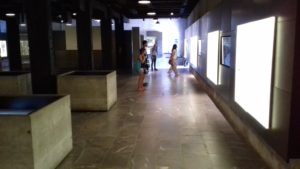
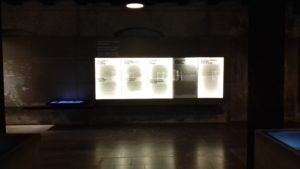
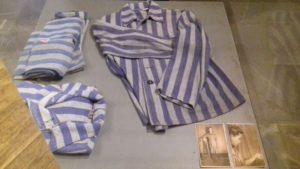
The “Risiera di San Sabba” trial took place in Trieste between 1976 and 1979.
Josef Oberhauser (last commandant of Risiera di San Sabba until its closure in late April 1945)
was sentenced to life imprisonment in absentia for his crimes but the Italian extradition request failed.
He died in November 1979 in Munich.
In the “Main exhibition Room“, you’ll find a lot of informations about the life of prisoners,
see objects that belonged to those who died in concentration camps in europe, photos of inmates etc …
One of the highlights is probably a model of the “Riseara di San Sabba” camp during during WWII.

-> In tranparent color, we see the buildings demolished during the transformation of the site into a monument.
-> In white color, we see the buildings that still exist now.
-> In grey color, we see reinforced concrete walls built during the transformation of the site into a monument.
-> In orange color, we see the rooms used for the killing and the crematorium which the nazis exploded.
You’ll be able to see where the crematorium used to be and how big was this concentration camp.
The architecture of Risiera di San Sabba is a bit different now because some buidlings were destroyed
and the architect who designed the museum in its current shape slightly changed the aspect of the former factory.
He added huge reinforced concrete walls in the courtyard, at the entrance and around a part of the former
factory that is now the “Commemoration Room”.
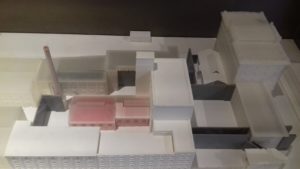
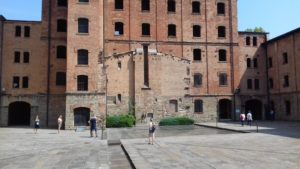

At the end of the visit, when you leave the museum, you’ll walk along the same narrow entrance.
You’ll probably still be in shock by all you’ve seen and learned during the visit.
But all in all, this place is really really worth a visit.
Those of you who like history (and are visiting Trieste) should absolutly visit this place.
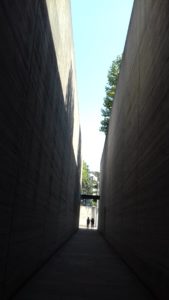
My tips for Risiera di San Sabba:
1/ Ask for an audioguide at the reception.
2/ Take 2 hours to visit the museum.
3/ Take a good look at the model of the Risiera.
4/ Take the bus n°8 in the city center to go there.